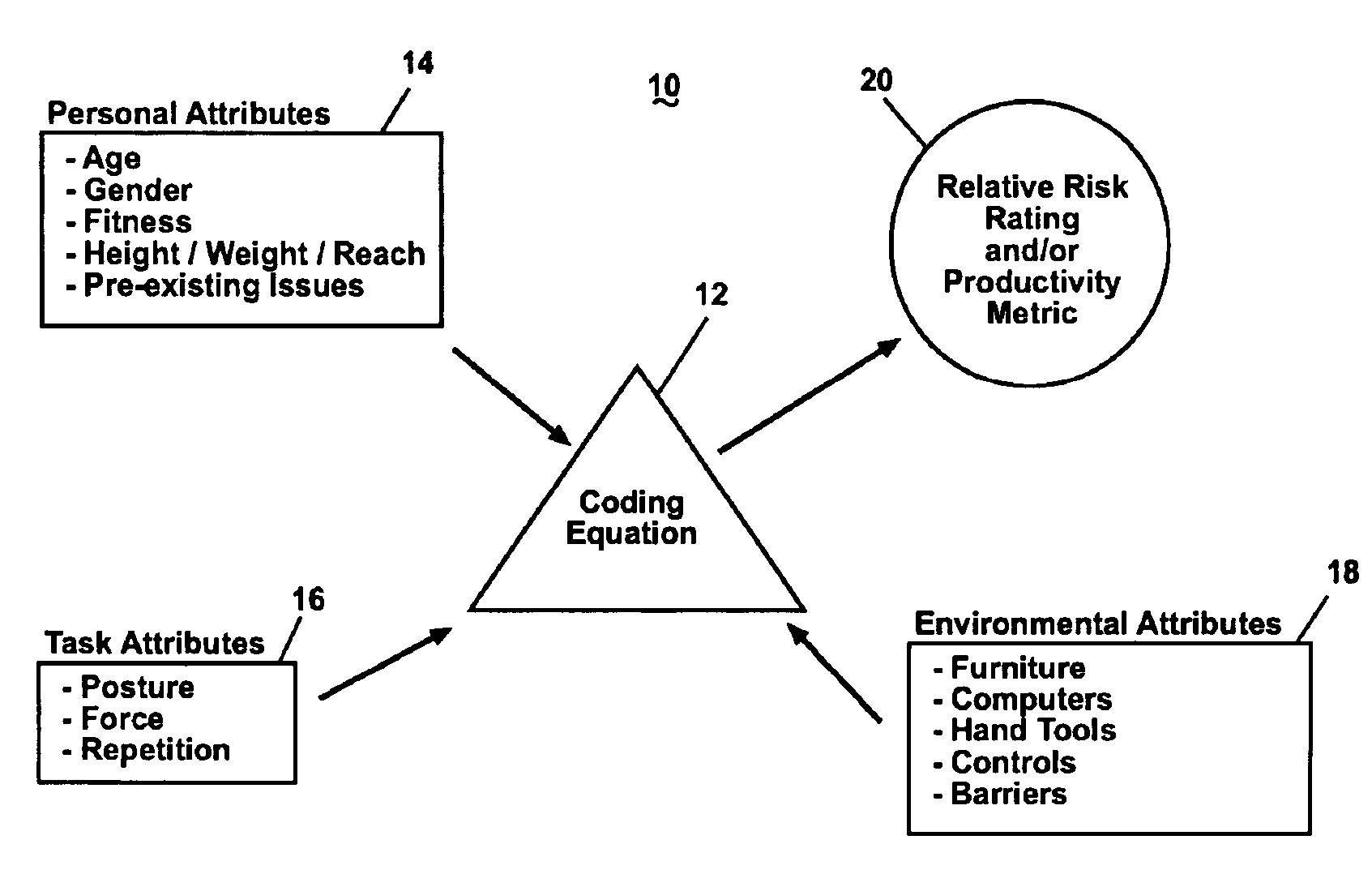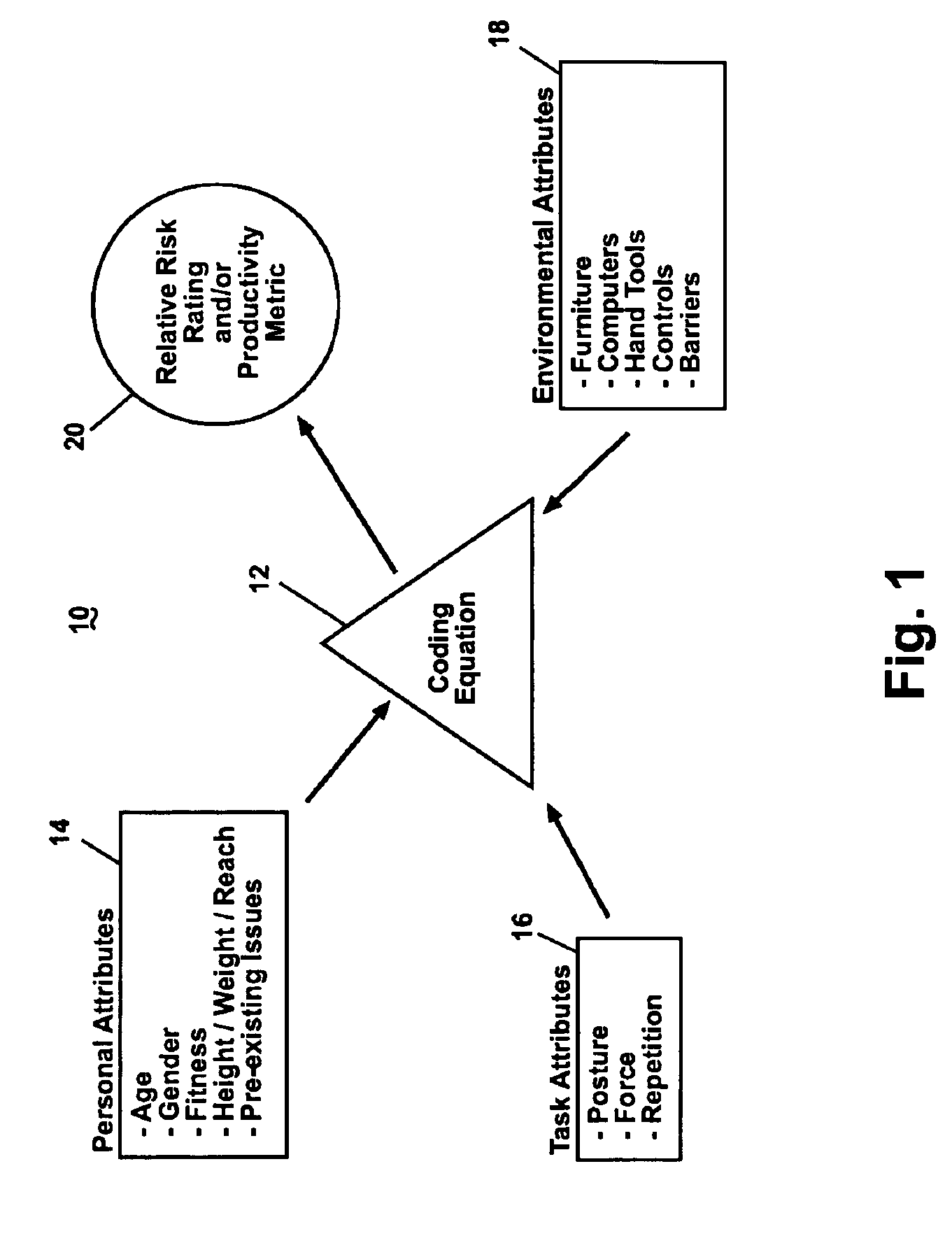Currently there are no standard ergonomics methods to evaluate the person (especially groups of people), their particular work-related task, and their environment (work
station,
assembly station, etc.).
Although there exist various methods by which the ergonomics of one subset of the above categories are used, there are no integrated methods of assessing the ergonomics of a work-related environment.
The measurement of ergonomics has been attempted but has not yielded satisfactory results.
These tools have not focused on acquiring data on large groups of people and provide little in the way of proactive solutions focused on company-based populations.
In addition, most of these solutions are difficult to duplicate, require expertise to utilize, and are created and empowered by a small group of individuals within small populations focused on reactive intervention, e.g., the ergonomics solutions are implemented after a work-related or repetitive
stress injury.
There is a general lack of integrated and systemic solutions that consider the person, their task, and their environment.
ROI models have been viewed as either incomplete or lacking in sophistication.
These broad-based methods are time-consuming.
They do not meet individual employee needs, and it is often prohibitively expensive to capture a sufficiently
large population sample to comprise a meaningful
database.
Employees working in a particular
workspace can suffer repetitive stress injuries and general discomfort when operating in an ergonomically-unbalanced environment.
This can result in additional costs to a company, such as with lost workdays, lower productivity, workers' compensation claims and the like.
For example, discomfort and / or injuries can occur in manufacturing workplaces, such as factories, retail workplaces, such as stores, and other workplaces, such as restaurants, vehicles (taxi cabs,
tractor trailers, delivery vehicles, etc.), and construction sites.
Further, children can be subject to an ergonomically-unbalanced environment at school, where they often sit in a chair at a
desk for long periods of time and perform repetitive tasks with or without additional equipment, such as computers.
In addition, once a company makes an office furniture
purchasing decision, there is no current
system to provide installation information on how to assure that an individual or a
user group implements the ergonomically-based
purchasing decisions with respect to settings and comfort positioning of the purchased office furniture.
It is also difficult to identify different ergonomic settings for a product.
However, companies
purchasing these items have no criteria to determine whether the office furniture is an ergonomic fit for each user in the workspace.
Further, there is no known user-friendly system proving customer safety and risk management teams the ability to audit and assure their employees are utilizing safe working habits (e.g., configuring their workspace to an optimal ergonomic fit).
Rather, employees often simply configure a workspace to their personal, subjective preferences without regard to optimal ergonomics because employees typically do not know when their environment is ergonomically correct.
This personal configuration dynamic is typically a result of a lack of feedback to office furniture manufacturers to guide
product design to fill product niches based on data relevant to optimal workplace ergonomics.
And, there is currently no industry-accepted system to validate the ergonomic claims of a
product design.
However, these attempts have not been pragmatic or useful.
Most solutions are difficult to duplicate, require expertise to utilize, can conflict with other available solutions, and are created and empowered by a small group of individuals within small populations focused on reactive intervention (i.e., typically only after lost workdays and reduced productivity).
Attempts to determine or model a customers ROI on an office furniture purchase have been viewed as either incomplete or lacking in sophistication and accuracy.
Many companies avoid productivity-measurement issues that are product- or
workstation-driven and ergonomic solutions have not been validated by outside entities to determine their validity or usefulness.
The same issues are prevalent in the office furniture retail industry.
There are even less options available to retail purchasers to define an ROI-based model to provide a
safer work environment and for the retail sales outlet to provide to the customer purchase options based on that data.
There is no known system to provide installation information on how to assure that the buyer implements ergonomic-based purchasing decisions.
There is no known user-friendly system to easily identify different ergonomic settings for a product and to easily communicate those settings to a purchasing
consumer (who may purchase a wide variety of products from different manufacturers).
Companies have developed individual ergonomic products but they do not effectively communicate appropriate ergonomic settings to the
consumer.
The same issues apply to other environments as well, such as a manufacturing workplace.
No known technology or system exists to predict productivity improvements or risk reduction in the manufacturing environment based on ergonomic data of both the person performing tasks, the task, as well as the environment in which the task is performed.
There is no known system to provide equipment installation information on how to assure that individual or
user group implements any ergonomic-based purchasing decisions.
There are no known user-friendly systems to be used by process designers, both internal and external to the manufacturer, to systematically consider optimizing the person(s), the task(s), and the environment.
There is no known user-friendly system to easily identify different ergonomic settings for a product.
There is no known user-friendly system providing customer safety and risk management teams the ability to audit and assure their employees are utilizing safe working habits.
Further, there is no
closed loop feedback system to guide
product design to fill product niches based on ergonomic data identified in the workplace.
These past attempted solutions are difficult to duplicate, require expertise to utilize, and are created and empowered by a small group of individuals within small populations focused on reactive intervention.
There is no known user-friendly approach.
These issues also exist in companies which desire to have so-called “safety audits” performed in their work environment (regardless of the particular field of endeavor of the company).
Single-user solutions exist, which have not focused on acquiring data on groups of people, and provide little in the way of proactive solutions focused on company-based populations.
Most solutions are difficult to duplicate, require expertise to utilize, and are created and empowered by a small group of individuals within small populations focused on reactive intervention.
There is a general lack of integrated solutions, which consider the person, task, and environment.
ROI models have been viewed as either incomplete or lacking in sophistication.
 Login to View More
Login to View More  Login to View More
Login to View More 


